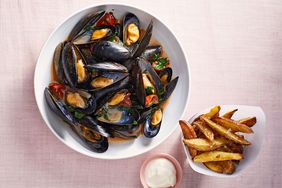
They can be daunting, but once you know how to eat oysters, the world of dining is, in fact, your oyster. Sublime on their own, or in tandem with other delectable shellfish on a seafood tower, raw oysters have the power to turn any happy hour, dinner, or gathering, into a festive celebration. At raw bars or at home, oysters not only get the party started—they're also somewhat sophisticated, especially when enjoyed with a glass of bubbly. We connected with seafood pros to glean tips for shucking, serving, and savoring this memorable mollusk.
- Ronna Welsh, author of The Nimble Cook and chef/owner of Purple Kale Kitchenworks, a cooking school in Brooklyn, NY
- Steven Wong, seafood specialist and owner of Aqua Best, a premium seafood purveyor in New York City
What Are Oysters?
Oysters, along with clams and mussels, are aquatic mollusks known as bivalves; the name pertains to the creature's two shells, called valves, connected by a hinge in the back.
Relatives of gastropods: Their mollusk cousins include snails and cephalopods, such as squid and octopus.
They're alive: Oysters flourish in freshwater and saltwater environments. They are usually sold by the dozen or half dozen and should still be alive when served raw.
Regional divide: The shells contain a soft, edible body, referred to as the meat, Oysters vary in taste, and appearance, depending on origin.
East Coast Vs. West Coast Oysters
:max_bytes(150000):strip_icc()/how_to_shuck_an_oyster_like_a_pro_horiz-370ee6f3839f49979e06f5e0a379fa69.jpg)
As with wine, the oyster's terroir, or area of the sea, impacts its flavor.
- West Coast oysters, harvested from the Pacific Ocean, have a ruffled shell and are sweet and delicate with notes of cucumber and melon.
- East Coast oysters are more briny and complex, with hints of seaweed and minerality, reflecting the saltier Atlantic Ocean. The shells are larger and smoother.
By comparing them in one sitting, you can distinguish the differences. "I love to eat oysters raw, tasting them side by side," says Ronna Welsh, author of The Nimble Cook and chef/owner of Purple Kale Kitchenworks, a cooking school in Brooklyn, NY. "You'll notice a difference in texture and taste from different types and regions that you'd miss without a variety from which to taste."
Prepping, Cleaning, and Shucking Oysters
If you're serving oysters at home, purchase a few elemental tools, and bear these preliminaries in mind.
:max_bytes(150000):strip_icc()/shucking-oyster-103341823-a99a8228dfdf46b5977ea1830ce94e00.jpg)
Clean the Oyster
You should always wash and scrub oysters before consumption, says Steven Wong, seafood specialist and owner of Aqua Best, which supplies high-end restaurants with premium fish. His method: "A toothbrush brushed between the hinges does wonders for not having dirt in your mouth."
Must-Have Tools
Prepping oysters entails getting to the meat in an efficient, safe way. Here's what's required:
Non-negotiables: "For eating oysters at home, you'll need an oyster knife, a rag, and ice," says Wong, adding that the oysters should be kept on ice, and always served cold.
Shucking knife: An oyster knife has a sharp enough tip for piercing the oyster but hopefully not your hand, should you slip, says Welsh. "The blade is strong, so it doesn't bend when you try to pry the oyster open." Another bonus: It has a slightly serrated edge for cutting around the shell.
Small fork: Wong notes that a fork can be dangerous if used to shuck shellfish but once the oyster is pried open, it has its purpose: Take your small fork (or oyster fork) and loosen the meat so that it's free of the shell.
How to Shuck Oysters
How to Eat Oysters
With the meat no longer tethered, it's time to enjoy the fruits of your shucking.
On the half shell: Raw bars always present raw oysters on the half shell, and you should do the same. The shell acts as a sort of cup for the mollusk meat.
Slurp it: Let the show begin! Pick up the half shell, bring it to your mouth, and angle it just so. "The best way to eat oysters, in my opinion, is chilled, raw, slurped right from the shell," says Welsh.
The chew factor: It's tempting to gulp that briny morsel and its liquid in one go, but the experts suggest taking it slow. "While you want to slurp oysters and their liquor straight from the shell, you don't want to swallow oysters whole," says Welsh. The different textures and tastes should be savored; chewing is a key aspect of that in-the-moment experience. "Chewing the oyster, especially the abductor muscle, makes the oyster taste sweeter," explains Wong.
Discard the shells: When you're done slurping, cast the shells aside on a designated plate.
:max_bytes(150000):strip_icc()/oysters-a130522-01-8429-md110267_horiz-ocms-2000-87ed3b3daea14584bde53ede2d32df5c.jpg)
Pairing Possibilities
A squeeze of lemon, a sprinkle of condiments, and a sparkling wine are all optional.
To dip: Oysters' natural brine pairs well with other acidic ingredients, such as vinegar, capers, and lemon, says Welsh. Wong stirs up a mignonette, a dipping sauce typically made with minced shallots, vinegar, and black pepper. He subs a lighter Champagne vinegar for the more expected apple cider vinegar, which he finds too sharp for the oyster. "There are purists who enjoy it without any accompaniments, or just the traditional horseradish and Tabasco," he adds.
To drink: Shellfish often goes hand in hand with a sparkler. "Champagne is light enough not to mask the oysters’ subtle flavor. Other white wines are great too," says Welsh. Sake also picks up on the bivalve's salinity.
Cooked Oysters
Oysters can also be cooked in the shell or out.
Pre-shucked: If you're planning on cooking them, perhaps by the dozen, note that some fishmongers sell oysters that are already shucked, in bulk, says Welsh.
Infinite options: “One of my favorite ways to cook oysters is to smoke them in the shell,” says Welsh. Wong adds that simple broiling and grilling techniques enhance the oysters' brininess. "You can pluck them out and enjoy them with a sauce or part of a dish," he says.



